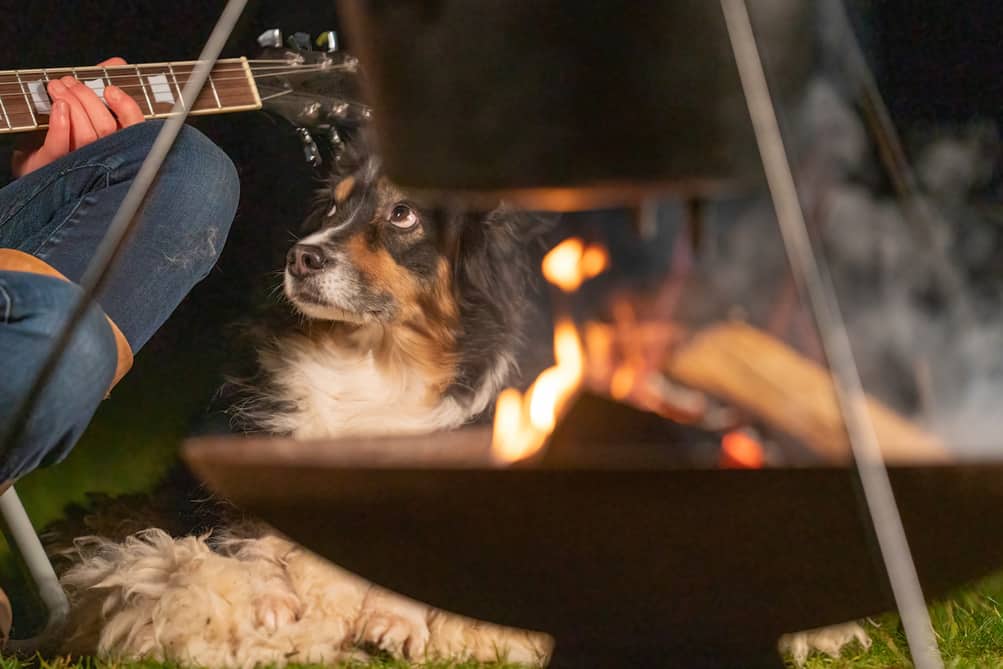Camping with your furry friend can be an incredible bonding experience, but it’s essential to prioritize safety, especially around campfires. This guide will help you ensure a safe and enjoyable camping trip with your canine companion.
Campfire Safety Basics
Keep your dog at a safe distance: Ensure your dog stays at least 3-4 feet away from the fire pit, even after the fire has gone out.
Use a leash or tether: Keep your dog on a leash or tether them to a secure spot upwind of the fire to prevent accidents.
Create a designated dog area: Set up a comfortable spot for your dog away from the fire, with a bed or blanket.
Never leave your dog unattended: Always supervise your dog around the campfire.
Understanding Dog Behavior Around Campfires
Dogs may react differently to campfires due to various factors:
- Some dogs may be naturally afraid of fire due to their wolf ancestry.
- The unpredictable crackling sounds can be unsettling for dogs.
- Heat from the fire can make dogs uncomfortable if they’re too close.
If your dog shows signs of fear or discomfort:
- Move them further away from the fire.
- Provide a safe, comfortable space.
- Use positive reinforcement to create positive associations with the campfire area.
For more tips on preparing your pet for outdoor adventures, check out our guide on how to train your dog for camping.
Campsite Setup for Dog Safety
- Choose a campsite with enough space to keep your dog away from the fire pit.
- Set up your dog’s sleeping area in the tent or a separate shelter away from the fire.
- Store food and treats securely to avoid attracting wildlife.
- Bring a portable fence or long lead to create a safe area for your dog to roam.
For more information on creating a dog-friendly campsite, read our article on tent camping with dogs.
Emergency Preparedness
- Pack a dog-specific first aid kit including:
- Sterile gauze pads and rolls
- Medical tape and self-adhering bandages
- Topical antibiotic ointment
- Saline solution for wound cleaning
- Tweezers for removing splinters or ticks
- A digital thermometer
- Any necessary medications
For a comprehensive guide on treating common outdoor injuries, check out our article on canine first aid for camping trips.
- Know the signs of smoke inhalation in dogs:
- Coughing or wheezing
- Difficulty breathing
- Red or watery eyes
- Lethargy or disorientation
- Familiarize yourself with the location of the nearest veterinary clinic or emergency animal hospital.
- Ensure your dog’s ID tags are up-to-date and consider microchipping before your trip.
Additional Tips for a Safe Camping Experience
- Bring essential camping gear for dogs, including collapsible water bowls, waste bags, and a dog-specific sleeping bag.
- Research dog-friendly hiking trails in the area before your trip to plan safe outdoor activities.
- Be prepared for warm weather by learning techniques for keeping your dog cool while camping.
By following these guidelines, you can enjoy a safe camping experience with your furry friend. Remember, a well-prepared camper is a happy camper – and that goes for our four-legged companions too!
Camping with dogs can be a rewarding experience when done safely. By prioritizing campfire safety and being prepared for emergencies, you can create lasting memories with your canine companion in the great outdoors. Always put your dog’s safety first, and don’t hesitate to adjust your plans if your pet seems uncomfortable or stressed. With proper preparation and awareness, you and your dog can enjoy many happy camping adventures together.

Leave a Reply